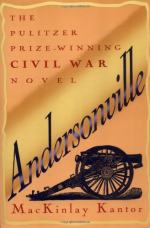Wirz’s headquarters were established in a large log house which had been built in the fort a little distant from the southeast corner of the prison. Every day—and sometimes twice or thrice a day—we would see great squads of prisoners marched up to these headquarters, where they would be searched, their names entered upon the prison records, by clerks (detailed prisoners; few Rebels had the requisite clerical skill) and then be marched into the prison. As they entered, the Rebel guards would stand to arms. The infantry would be in line of battle, the cavalry mounted, and the artillerymen standing by their guns, ready to open at the instant with grape and canister.
The disparity between the number coming in from the Army of the Potomac and Western armies was so great, that we Westerners began to take some advantage of it. If we saw a squad of one hundred and fifty or thereabouts at the headquarters, we felt pretty certain they were from Sherman, and gathered to meet them, and learn the news from our friends. If there were from five hundred to two thousand we knew they were from the Army of the Potomac, and there were none of our comrades among them. There were three exceptions to this rule while we were in Andersonville. The first was in June, when the drunken and incompetent Sturgis (now Colonel of the Seventh United States Cavalry) shamefully sacrificed a superb division at Guntown, Miss. The next was after Hood made his desperate attack on Sherman, on the 22d of July, and the third was when Stoneman was captured at Macon. At each of these times about two thousand prisoners were brought in.
By the end of May there were eighteen thousand four hundred and fifty-four prisoners in the Stockade. Before the reader dismisses this statement from his mind let him reflect how great a number this is. It is more active, able-bodied young men than there are in any of our leading Cities, save New York and Philadelphia. It is more than the average population of an Ohio County. It is four times as many troops as Taylor won the victory of Buena Vista with, and about twice as many as Scott went into battle with at any time in his march to the City of Mexico.
These eighteen thousand four hundred and fifty-four men were cooped up on less than thirteen acres of ground, making about fifteen hundred to the acre. No room could be given up for streets, or for the usual arrangements of a camp, and most kinds of exercise were wholly precluded. The men crowded together like pigs nesting in the woods on cold nights. The ground, despite all our efforts, became indescribably filthy, and this condition grew rapidly worse as the season advanced and the sun’s rays gained fervency. As it is impossible to describe this adequately, I must again ask the reader to assist with a few comparisons. He has an idea of how much filth is produced, on an ordinary City lot, in a week, by its occupation by a family say of six persons. Now let him imagine what would be the result if that lot, instead of having upon it six persons, with every appliance for keeping themselves clean, and for removing and concealing filth, was the home of one hundred and eight men, with none of these appliances.




